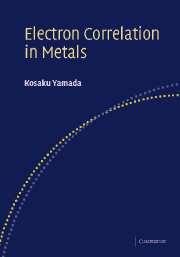Book contents
- Frontmatter
- Contents
- Preface
- 1 Fermi gas
- 2 Fermi liquid theory
- 3 Anderson's orthogonality theorem
- 4 s–d Hamiltonian and Kondo effect
- 5 Anderson Hamiltonian
- 6 Hubbard Hamiltonian
- 7 Fermi liquid theory of strongly correlated electron systems
- 8 Transport theory based on Fermi liquid theory
- 9 Superconductivity in strongly correlated electron systems
- Appendix A Feynman relation
- Appendix B Second quantization
- Appendix C Interaction representation and thermal Green's function
- Appendix D Linear response theory
- Appendix E Transport equation derived by Éliashberg
- Index
3 - Anderson's orthogonality theorem
Published online by Cambridge University Press: 23 December 2009
- Frontmatter
- Contents
- Preface
- 1 Fermi gas
- 2 Fermi liquid theory
- 3 Anderson's orthogonality theorem
- 4 s–d Hamiltonian and Kondo effect
- 5 Anderson Hamiltonian
- 6 Hubbard Hamiltonian
- 7 Fermi liquid theory of strongly correlated electron systems
- 8 Transport theory based on Fermi liquid theory
- 9 Superconductivity in strongly correlated electron systems
- Appendix A Feynman relation
- Appendix B Second quantization
- Appendix C Interaction representation and thermal Green's function
- Appendix D Linear response theory
- Appendix E Transport equation derived by Éliashberg
- Index
Summary
The Fermi liquid possesses an infinite number of electron–hole pair excitations in the vicinity of the Fermi surface and can be considered an infinitely degenerate system. Because of this nature the Fermi surface is largely transformed even by a small perturbation. The fragility of the Fermi surface gives rise to interesting physics, such as superconductivity and the various many-body problems related to the Fermi surface. A typical example is the Kondo effect. In this chapter, we consider the system of dilute impurity atoms in metals.
First, in Section 3.1, we consider the screening effect of an impurity charge in metals, following the Friedel theory. In Section 3.2, we explain Anderson's orthogonality theorem as a singularity originating from the infinite number of lowenergy excitations near the Fermi energy in metals. In Sections 3.3 and 3.4, we introduce the photoemission due to soft X-rays and the quantum diffusion of charged particles in metals, respectively, as typical examples in which the orthogonality theorem plays an important role.
Friedel sum rule
Let us assume that there exists an impurity atom in a normal metal such as Cu, Ag or Al. Owing to the local impurity potential V(r), the electron distribution around the impurity changes. The local change of electron number was calculated by Friedel in 1958. We introduce it here.
- Type
- Chapter
- Information
- Electron Correlation in Metals , pp. 29 - 48Publisher: Cambridge University PressPrint publication year: 2004

